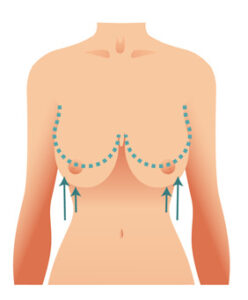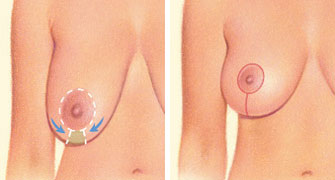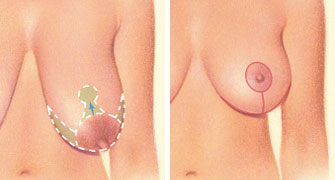
Breast Lift
What is breast lift surgery?
A breast lift, also known as mastopexy, raises the breasts by removing excess skin and tightening the surrounding tissue to reshape and support the new breast contour.
New statistics from the American Society of Plastic Surgeons show breast lifts have grown 70% since 2000, outpacing breast implants 2-to-1.
Sometimes the areola becomes enlarged over time, and a breast lift will reduce this as well.
A breast lift can rejuvenate your figure with a breast profile that is more youthful and uplifted. A woman’s breasts often change over time, losing their youthful shape and firmness. These changes and loss of skin elasticity can result from:
- Pregnancy
- Breastfeeding
- Weight fluctuations
- Aging
- Gravity
- Heredity

What are the steps of a breast lift procedure?
Your breast lift procedure can be achieved through a variety of incision patterns and techniques.
The appropriate technique for you will be determined based on:
- Breast size and shape
- The size and position of your areolas
- The degree of breast sagging
- Skin quality and elasticity as well as the amount of extra skin
Step 1 – Anesthesia
Medications are administered for your comfort during the surgical procedure. The choices include intravenous sedation and general anesthesia. Your doctor will recommend the best choice for you.
Step 2 – The incision
There are three common incision patterns:
Around the areola

Around the areola and vertically down from the areola to the breast crease

Around the areola, vertically down from the breast crease and horizontally along the breast crease

Step 3 – Reshaping your breasts
After your doctor makes the incisions:
- The underlying breast tissue is lifted and reshaped to improve breast contour and firmness.
- The nipple and areola are repositioned to a natural, more youthful height.
- If necessary, enlarged areolas are reduced by excising skin at the perimeter.
- Excess breast skin is removed to compensate for a loss of elasticity.
Step 4 – Closing the incisions
After your breasts are reshaped and excess skin is removed, the remaining skin is tightened as the incisions are closed.
Some incision lines resulting from breast lift are concealed in the natural breast contours; however, others are visible on the breast surface. Incision lines are permanent, but in most cases will fade and significantly improve over time.
Many women desire the smallest scar possible. However, your plastic surgeon will recommend the incisions which best suit your anatomy.
Listen to your surgeon and do not diminish your result by demanding an incision that will not be appropriate for you.
Sutures are layered deep within the breast tissue to create and support the newly shaped breasts. Sutures, skin adhesives and/or surgical tape may be used to close the skin.
Step 5 – See the results
The results of your breast lift surgery are immediately visible. Get more information about breast lift results.
What should I expect during my breast lift recovery?
During your breast lift recovery, dressings or bandages will be applied to the incisions after the procedure is completed.
You’ll need to wear an elastic bandage or support bra to minimize swelling and support your breasts as they heal.
A small, thin tube may be temporarily placed under the skin to drain any excess blood or fluid that may collect.You will be given specific instructions that may include:
- How to care for your breasts following surgery
- Medications to apply or take orally to aid healing and reduce the potential for infection
- Specific concerns to look for at the surgical site or in your general health
- When to follow up with your plastic surgeon.
Be sure to ask your plastic surgeon specific questions about what you can expect during your individual breast lift recovery period.
- Where will I be taken after my surgery is complete?
- What medication will I be given or prescribed after surgery?
- Will I have dressings/bandages after surgery? When will they be removed?
- Are stitches removed? When?
- When can I resume normal activity and exercise?
- When do I return for follow-up care?













